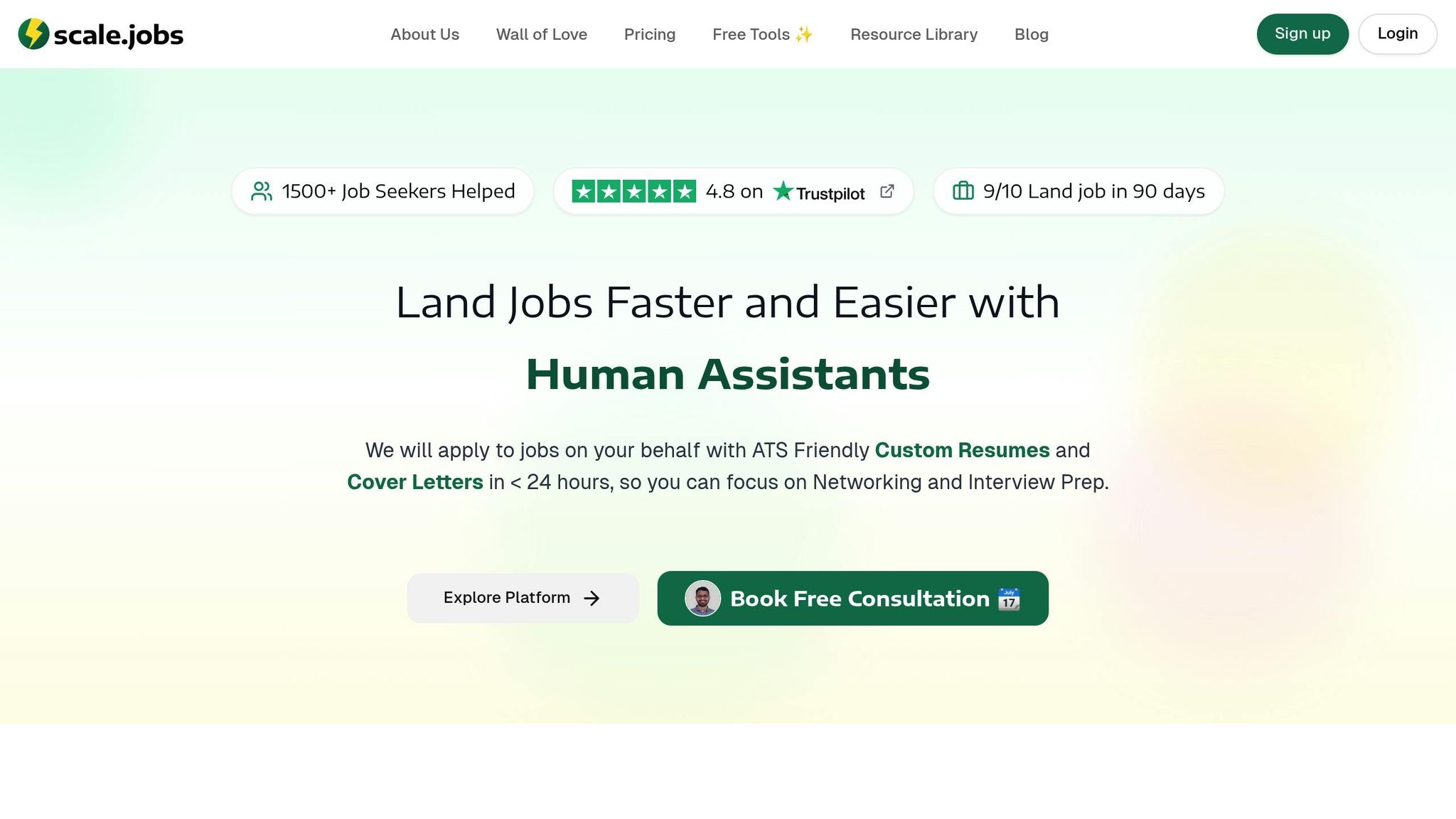How to Format Testimonials for ATS Resumes
Learn how to effectively format testimonials for ATS-friendly resumes to enhance credibility and visibility to recruiters.

Adding testimonials to your resume can boost your credibility, but they must be formatted correctly to pass ATS (Applicant Tracking Systems). ATS software often struggles with complex layouts, decorative elements, or unconventional sections, which can make your testimonials invisible to recruiters. Here’s how to ensure your testimonials work seamlessly with ATS:
- Place testimonials in standard sections like "Professional Summary" or "Work Experience" instead of headers, sidebars, or text boxes.
- Use plain text formatting with standard fonts (Arial, Calibri) and straightforward quotation marks.
- Keep testimonials concise - limit them to one or two sentences highlighting specific achievements or skills.
- Reframe testimonials into bullet points that showcase measurable results and align with job keywords.
By following these steps, you’ll create a resume that stands out to both ATS systems and recruiters.
Now, let’s explore the details of how to format and position testimonials effectively.
Understanding ATS and Resume Formatting Requirements
What is an ATS and How Does it Work?
An Applicant Tracking System (ATS) is software designed to screen and organize resumes before they land in the hands of human recruiters. It’s like a digital filter, scanning resumes for key details such as work experience, education, and skills, and ranking candidates based on keyword matches.
Here’s the catch: ATS systems often struggle with unconventional formatting. Creative layouts, unique fonts, graphics, text boxes, tables, or even headers and footers can trip up the system. When the ATS encounters formatting it can’t process, it may skip over that content entirely or place it in the wrong section of your resume.
This poses a specific problem for testimonials. Job seekers often use decorative boxes, sidebars, or quotes for these endorsements. Unfortunately, ATS systems may fail to read them correctly, leaving that glowing recommendation from your previous manager hidden from both the system and the recruiter.
ATS Formatting Requirements You Must Follow
To ensure your resume gets through the ATS, you need to stick to some formatting rules:
- Use standard section headers. ATS systems recognize headings like "Work Experience", "Education", "Skills", and "Professional Summary." Avoid creative alternatives like "My Journey" or "What Others Say About Me", as they can confuse the system and miscategorize your information.
- Stick to plain text and standard fonts. Choose fonts like Arial, Calibri, or Times New Roman in sizes 10–12 pt. Decorative fonts or design elements can interfere with how the ATS reads your resume.
- Pick the right file format. While many systems handle both .docx and .pdf files, some older ATS platforms struggle with PDFs, especially those created with design software. Unless a specific format is requested, submitting your resume as a .docx file is the safest bet.
- Use consistent spacing and alignment. Stick to standard margins (0.5 to 1 inch), single or 1.15 line spacing, and align text to the left. Avoid justified text, as it can create irregular spacing that confuses the ATS.
- Keep bullet points simple. Use standard round bullets (•) or hyphens (-). Complex symbols like arrows, stars, or custom icons might not translate correctly, leading to errors.
Now, let’s dive into how poor testimonial formatting can create even bigger problems for your resume.
How Bad Testimonial Formatting Can Hurt Your Resume
Even with the right formatting elsewhere, overly creative testimonial placements can cause critical information to be missed by the ATS. Testimonials placed in text boxes, headers, or sidebars often become invisible to the system, meaning your hard-earned recommendations won’t be seen.
Improper quote formatting is another issue. Testimonials often include quotation marks or italicized text, but some ATS systems struggle to interpret these special characters, leading to missing or garbled text in your parsed resume.
Parsing errors can also occur. If the ATS can’t interpret the formatting, it might misplace your testimonial in the wrong section. For example, a testimonial praising your leadership skills might accidentally end up in your education section, creating confusion for recruiters.
Automatic rejection is the worst-case scenario. Some ATS systems reject resumes with excessive parsing errors or unreadable content, meaning your resume never even reaches a recruiter’s desk - no matter how qualified you are.
The solution? Strike a balance between making your testimonials easy to read for the ATS and visually appealing for humans. Integrate them into standard resume sections and use formatting that both systems and recruiters can process without a hitch.
Your Resume Is Getting REJECTED by ATS (Here’s How to FIX IT) + FREE TEMPLATE INSIDE!
How to Add Testimonials to ATS-Friendly Resumes
To make your testimonials work both for ATS systems and human recruiters, it's all about where you place them and how you format them. The goal is to integrate testimonials in a way that enhances your resume's readability and effectiveness without complicating its ATS compliance.
Where to Place Testimonials on Your Resume
Instead of creating a separate section for testimonials or references, include them within standard sections like Professional Summary, Work Experience, or Skills. ATS systems are designed to recognize these headings, so sticking to them ensures your resume is parsed correctly.
Your Professional Summary is a great spot for a short, compelling testimonial. Since this section is at the top of your resume, both ATS systems and recruiters will likely see it first. A well-placed quote here can establish credibility right away.
The Work Experience section is another strong option. You can add testimonials under specific roles, especially when they back up the achievements or responsibilities listed for that position. This not only reinforces your accomplishments but also provides third-party validation.
Avoid placing testimonials in non-standard areas like headers, footers, sidebars, or text boxes. Stick to the main sections of your resume to ensure ATS systems can read them without issues.
How to Format Testimonials for ATS Systems
Formatting testimonials properly is key to making them ATS-friendly:
- Use straight quotation marks (
"") to clearly indicate the testimonial content. - Keep testimonials brief. Limit them to one or two impactful sentences to ensure clarity and avoid overwhelming the ATS.
- Stick to plain text. While bold or italicized text might look appealing to human readers, it can trip up ATS systems.
- Include the source of the testimonial in a straightforward way. For example:
" - Sarah Johnson, Marketing Director."Avoid using special characters or complex formatting that could confuse the system.
Here’s an example of a properly formatted testimonial for your resume:
"Recognized by clients for 'exceptional attention to detail and project delivery,' I bring five years of experience managing cross-functional teams and consistently exceeding project deadlines."
Turn Testimonials into Achievement-Based Bullet Points
You can also use testimonials as inspiration to create quantified, achievement-focused bullet points. Instead of directly quoting the testimonial, rephrase it to highlight measurable results and action-oriented accomplishments. This approach not only aligns with ATS keyword requirements but also emphasizes your impact.
For example, take a quote like:
"John was a fantastic project manager."
And turn it into:
"Led cross-functional team to deliver projects ahead of schedule, earning client praise for leadership."
If the testimonial mentions soft skills, tie it to relevant metrics or results. For instance, feedback about "outstanding communication skills" could be reworked into:
"Consistently received feedback such as 'outstanding communication skills' from clients, contributing to a 20% increase in repeat business."
This strategy allows you to leverage testimonials while focusing on results and keywords that resonate with both ATS systems and recruiters.
ATS Resume Tools: Scale.jobs vs Jobscan vs Rezi.ai

When it comes to crafting an ATS-friendly resume, the tools you use can make all the difference. With more than 90% of Fortune 500 companies relying on ATS software to screen applications - and up to 75% of resumes never making it to a human reviewer due to filtering errors - choosing the right platform is critical.
Resume Platform Comparison: Features and ATS Compliance
Let’s take a closer look at three popular platforms for building ATS-compliant resumes: Scale.jobs, Jobscan, and Rezi.ai. Each offers distinct features tailored to different needs.
Scale.jobs provides a comprehensive solution with free tools, AI-powered customization, and human review services. Their free ATS checker and actionable feedback engine pinpoint potential formatting issues, including problems with integrating testimonials. Human assistants are available to manually review resumes, ensuring testimonials are formatted correctly and strategically placed.
Jobscan specializes in ATS optimization through keyword matching and job-specific resume scans. While it excels at identifying whether testimonials include relevant keywords, it doesn’t offer guidance on formatting or placement for ATS compliance.
Rezi.ai uses AI to build resumes with built-in ATS checks. It can convert testimonials into concise, achievement-based bullet points. However, users sometimes report formatting challenges with more complex resumes.
| Platform | ATS Checker | AI Resume Builder | Human Assistant | Testimonial Integration | Pricing Model |
|---|---|---|---|---|---|
| Scale.jobs | Yes (Free) | Yes (Pro) | Yes (Flat Fee) | Achievement bullets | Free, $9/$19 Pro, Flat Fee |
| Jobscan | Yes | No | No | Keyword matching | $49.95/month |
| Rezi.ai | Yes | Yes | No | AI bullet conversion | $29/month |
This breakdown highlights why Scale.jobs stands out as a leader in ATS resume tools.
Why Scale.jobs Beats Other Resume Platforms
Scale.jobs outshines Jobscan and Rezi.ai, particularly when it comes to handling testimonials in ATS-friendly resumes.
Human review for testimonials is a game-changer. Unlike Jobscan and Rezi.ai, which rely solely on automation, Scale.jobs employs trained human assistants to review and refine how testimonials are incorporated. This ensures testimonials are properly formatted and strategically placed in sections like the Professional Summary or Work Experience, making them both impactful and ATS-compliant.
Free tools with no strings attached make Scale.jobs especially appealing. Their free ATS checker and actionable feedback engine help identify testimonial formatting issues without requiring upfront payments. This is a huge benefit for those on tight budgets, such as recent graduates, laid-off professionals, or immigrants navigating visa-related job searches.
Flat-fee pricing eliminates the hassle of recurring subscriptions. Instead of monthly charges, Scale.jobs offers one-time bundles starting at $199 for up to 250 job applications. This approach delivers better value for job seekers who need ongoing support during their search.
Real-time updates and proof-of-work screenshots via WhatsApp add a layer of transparency. These updates confirm that testimonials are properly handled in each application. Neither Jobscan nor Rezi.ai offers this level of personalized service or accountability.
Compatibility across multiple formats ensures that Scale.jobs can handle testimonials for any job portal or ATS system, whether it’s a corporate platform or a niche industry board. Automated tools like Jobscan and Rezi.ai may overlook how different systems interpret testimonial content, increasing the risk of errors.
With its combination of free ATS testing, AI customization, and human expertise, Scale.jobs offers a well-rounded solution for maximizing the impact of testimonials in resumes. Up next, we’ll dive into common testimonial formatting mistakes and how to avoid them.
Common Testimonial Mistakes and How to Fix Them
If your testimonials aren't formatted correctly, they might not even make it past the Applicant Tracking System (ATS). With 99% of recruiters relying on ATS to filter resumes, ensuring your testimonials are properly integrated is essential. Here's a closer look at common mistakes and how to fix them.
Common Testimonial Formatting Errors
ATS systems are designed to prioritize standard formatting and keywords, so even small missteps can make an impact. Here are some frequent errors that can hurt your chances:
- Using non-standard headers, tables, or text boxes: ATS software is programmed to recognize standard headers like "Work Experience" or "Skills." If you use headers like "What Others Say" or "Client Praise", the system might skip over your testimonials entirely.
- Overly long quotes: Lengthy testimonials can overshadow your qualifications. Instead, break them down into concise, results-driven statements that focus on specific skills or achievements.
- Irrelevant testimonials: Including testimonials that don't align with the job you're targeting - like ones referencing outdated skills or unrelated industries - can confuse ATS systems and dilute your application.
- Images: While visually appealing, testimonials in image form are invisible to ATS. They simply can't be read by the system.
How to Fix ATS Issues with Testimonials
Once you understand the common pitfalls, it’s time to make sure your testimonials are ATS-friendly. Here's how:
- Use ATS checkers: Tools like Scale.jobs' free Resume ATS Checker can help you identify formatting issues, missing keywords, or sections that ATS might not recognize.
- Review the ATS output: Upload your resume and check how the ATS processes your testimonials. If they’re missing or appear scrambled, adjustments are needed.
- Stick to standard headers: Use clear section titles like "Professional References" or "Testimonials." Alternatively, integrate testimonials into sections like "Work Experience" or "Professional Summary."
- Revise long quotes: Turn lengthy testimonials into bullet points that emphasize measurable achievements or relevant skills. Focus on outcomes that match the job description.
- Check file formats: Most ATS systems work well with .docx files, but always follow the employer’s specified format to avoid compatibility issues.
- Choose standard fonts: Stick to simple fonts like Arial, Calibri, or Times New Roman. Avoid decorative fonts or unusual formatting that could confuse the system.
- Test your changes: After making updates, run your resume through ATS checkers again to ensure everything is processed correctly. Even small tweaks can make a big difference.
Making Testimonials Work in Your ATS Resume
To effectively incorporate testimonials into your ATS-friendly resume, you’ll need to strike a balance between making it readable for both hiring managers and applicant tracking systems (ATS). The trick is to transform testimonials into achievement-focused statements that seamlessly include relevant keywords while still showcasing your credibility.
Start by condensing lengthy testimonials into short, quantified bullet points that emphasize results. For instance, instead of saying, "I was great at managing projects," reframe it as, "Managed multiple high-priority projects, delivering results ahead of schedule." This not only makes the statement more impactful but also aligns it with ATS requirements.
Next, analyze the job description to identify key skills and phrases. If a role highlights terms like "cross-cultural communication" or "global collaboration", adapt your testimonials to naturally include these keywords. Doing so not only boosts your ATS ranking but also ensures your resume resonates with recruiters.
When formatting, place these revised testimonials under standard headers like "Work Experience" or "Professional Summary." Avoid using unconventional headers such as "Client Praise", as these might confuse ATS software. Additionally, save your resume in .doc or .txt format unless the job posting specifies otherwise, as some ATS systems struggle with PDFs.
To ensure your resume is ATS-ready, test it using tools like Scale.jobs, which offers a free Resume ATS Checker. This tool can help identify formatting issues and confirm that your testimonials are visible to the ATS.
Finally, be selective about the testimonials you include. Focus on those that reflect recent, role-relevant achievements. For instance, if you’re applying for a managerial position, emphasize testimonials that highlight your project management skills and leadership successes. By following these steps, you’ll create a resume that stands out to both ATS systems and human recruiters.
FAQs
How do I include testimonials on my resume so they are ATS-friendly and appealing to recruiters?
To ensure testimonials work seamlessly with ATS systems and catch the eye of recruiters, incorporate them as plain text within relevant sections of your resume. For example, you can place them under specific job roles or accomplishments. Steer clear of using images, graphics, or intricate formatting, as these elements often can't be processed by ATS software.
Another option is to dedicate a separate section titled "Testimonials" or "Endorsements" for standout quotes. Keep the formatting straightforward and text-based to maintain ATS compatibility while still showcasing compelling social proof for recruiters. This method strikes a great balance between practicality and making an impression.
What mistakes should I avoid when adding testimonials to an ATS-friendly resume?
When adding testimonials to an ATS-friendly resume, steer clear of images, graphics, or overly designed elements such as tables or decorative fonts. These systems are built to process plain text, and incorporating such features can lead to parsing issues, potentially hiding your testimonials from recruiters.
To avoid this, keep your testimonials in plain text and present them briefly and clearly. For instance, you might include a short quote with proper attribution, like: "John's leadership skills transformed our team's performance" – Former Manager. This approach ensures your testimonials are visible and impactful without interfering with ATS functionality.
How can I turn a client testimonial into a strong, achievement-focused bullet point for my resume?
To transform a client testimonial into a compelling, results-driven bullet point, focus on turning vague praise into measurable outcomes. Include specific numbers, percentages, or tangible results that clearly demonstrate your impact. For instance, instead of a generic statement like "John was great at improving team performance," you could rewrite it as: "Increased team productivity by 25% in three months by introducing streamlined workflows."
A helpful way to structure these points is by using the STAR method (Situation, Task, Action, Result). This approach ensures your achievements are presented clearly, making them stand out to recruiters and compatible with applicant tracking systems (ATS).




